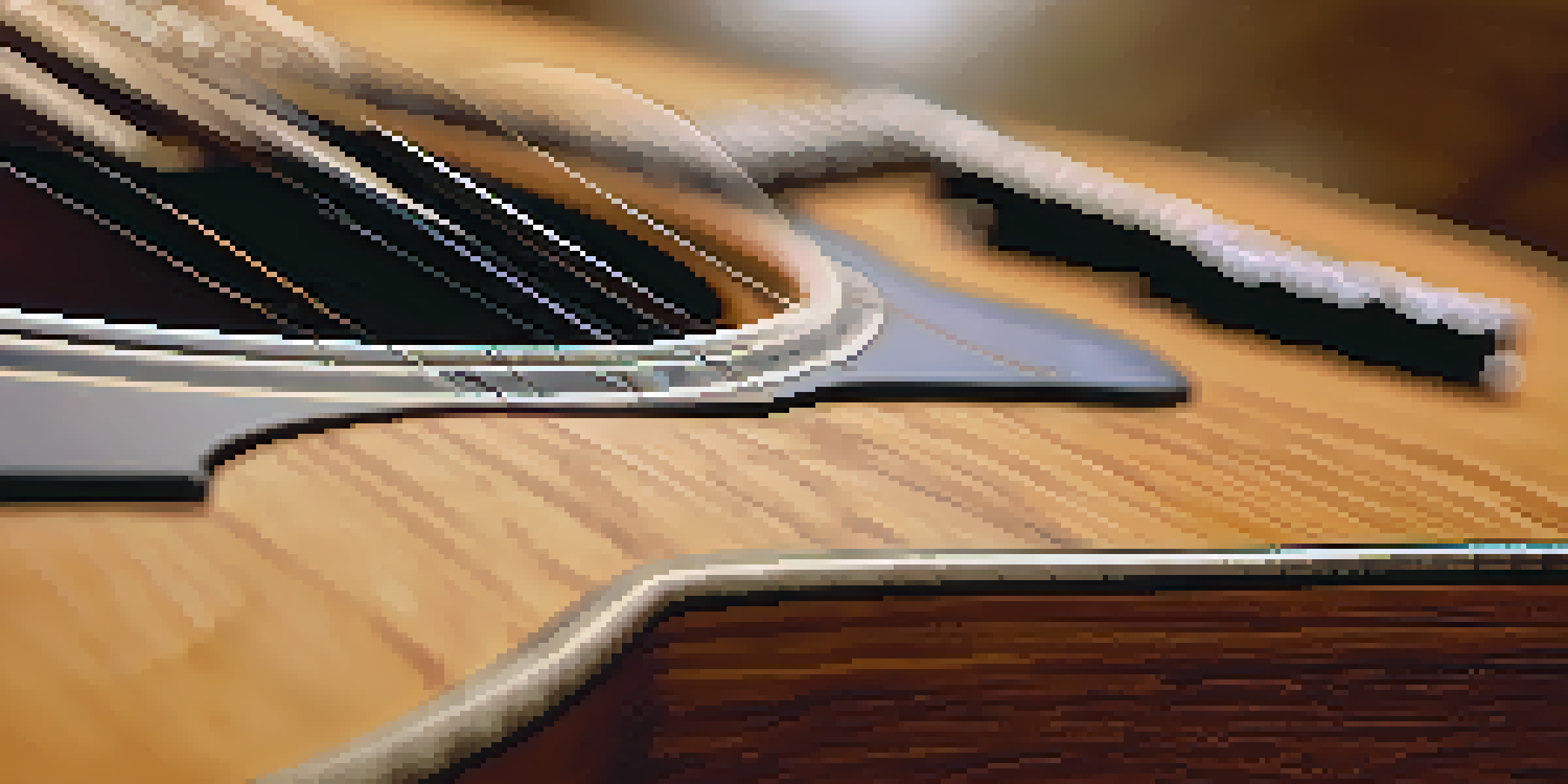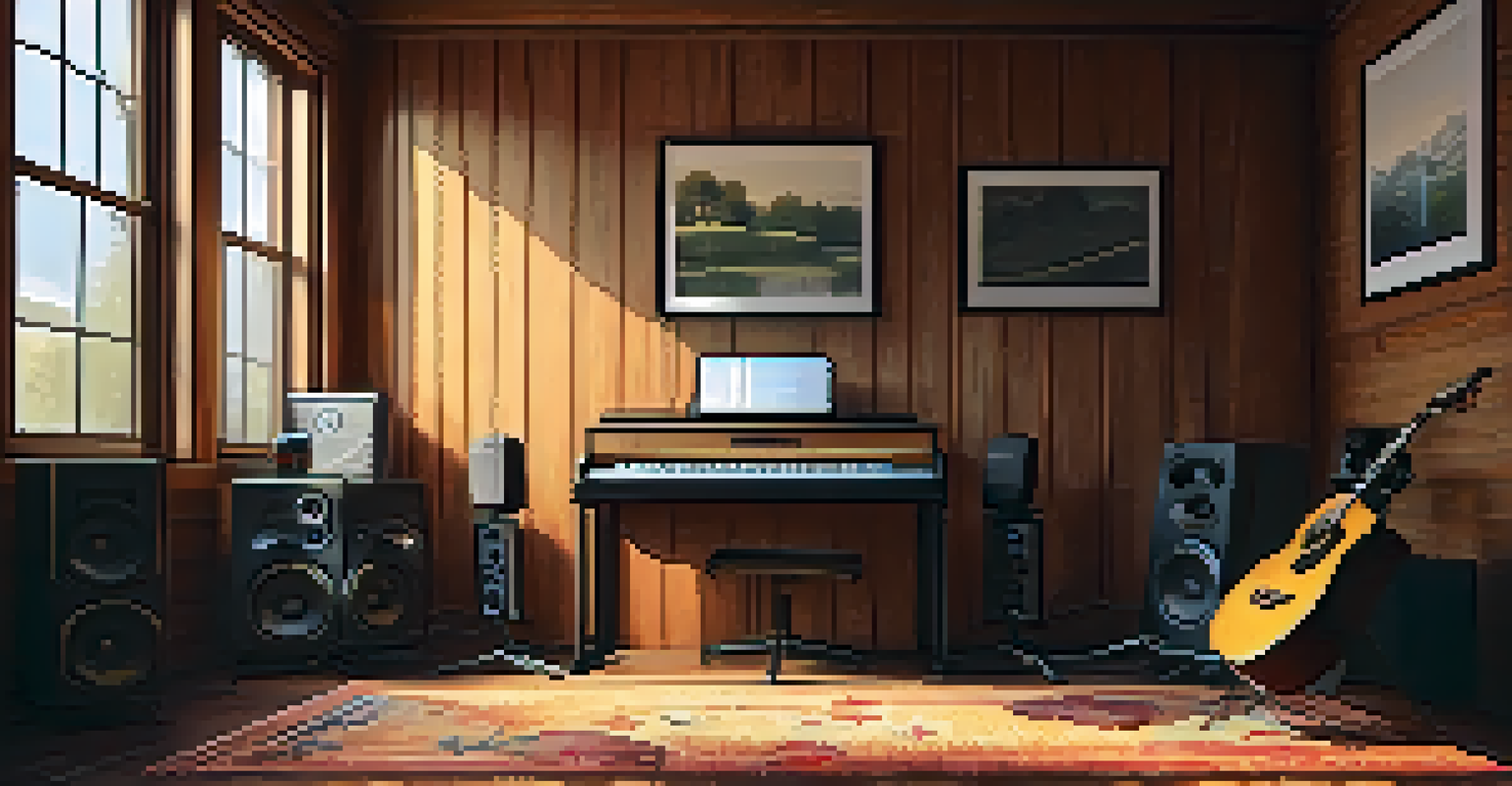Microphone Placement Strategies for Guitar Recording Success

Understanding the Importance of Microphone Placement
Microphone placement is crucial in achieving high-quality guitar recordings. Just as the right angle can change a photograph, the position of your mic can dramatically affect the sound. It’s not just about the equipment; it’s about how you use it to capture the nuances of your instrument.
The microphone is a powerful tool that can capture the essence of your sound, but only if you know how to use it properly.
Guitars can produce a wide range of tones, and the microphone's location can highlight certain characteristics. For example, placing the mic too close can result in a boomy sound, while positioning it too far may lead to a thin and distant tone. Understanding these dynamics is the first step toward effective recording.
By experimenting with different placements, you can find the sweet spot that best represents your guitar's unique voice. This exploration not only enhances the quality of your recordings but also helps you develop your ear for sound, which is essential for any musician.
Choosing the Right Microphone for Guitar
The type of microphone you choose can greatly influence your recording. Dynamic microphones are often favored for their durability and ability to handle high sound pressure levels, making them ideal for live settings. On the other hand, condenser microphones are sensitive and capture more detail, which can be perfect for studio recordings.

Each microphone type has its unique sonic characteristics, and understanding these can help you select the best tool for your desired sound. For instance, if you're going for a crisp, bright tone, a condenser mic might be your best bet. Conversely, if you're looking for a warmer, fuller sound, a dynamic mic could be the way to go.
Microphone Placement Matters
The position of your microphone can dramatically influence the quality and character of your guitar recordings.
Don't hesitate to try out different microphones. It's like tasting various dishes at a restaurant; you won't know what you love until you sample a bit of everything.
Close Mic Technique for Intimacy and Detail
Close mic technique involves placing the microphone just a few inches away from the guitar, capturing a detailed and intimate sound. This technique is particularly effective for solo performances or when you want the guitar to stand out in a mix. It allows the listener to feel the nuances of each strum and finger movement.
Recording is not just about the gear; it’s about how you capture the moment and the emotion behind the music.
However, be cautious with this approach, as it can easily pick up unwanted noises, such as string squeaks or fret buzz. Using a high-pass filter during recording can help eliminate some of these unwanted frequencies, allowing for a cleaner sound. Additionally, consider using a pop filter to reduce plosive sounds.
Experimenting with distance can yield fascinating results; try moving the mic slightly further away to see how it changes the tone. This trial and error can help you discover the perfect balance for your recording.
Utilizing Distance for Ambient Sound Capture
Using distance in microphone placement can create a more ambient sound, capturing the room's acoustics along with the guitar. This technique is particularly effective in larger spaces where the natural reverb can enhance the recording. By positioning the microphone several feet away, you can achieve a more organic, live sound.
This method works well for fingerstyle guitar or when you want to convey a sense of space in your music. The added ambiance can bring warmth and character to your recordings, making them feel fuller and more immersive. It’s akin to inviting your audience into a live performance.
Choosing the Right Microphone
Selecting between dynamic and condenser microphones is essential for achieving the desired sound quality in your recordings.
However, be aware that this technique can also pick up unwanted background noise. Finding a quiet space and using directional microphones can help you mitigate this issue, allowing for a balanced and rich recording.
Experimenting with Angles for Unique Tones
The angle at which you place the microphone can significantly affect the tone you capture. Tilting the mic slightly towards the sound hole or the fretboard can yield different tonal qualities, making your recordings more dynamic. It's like choosing the right lighting for a photo; the angle can reveal hidden beauty.
For instance, angling the microphone towards the neck can emphasize the higher frequencies, resulting in a brighter sound. Conversely, pointing it towards the body of the guitar may produce a warmer tone. This experimentation allows you to find the perfect blend that suits your style.
Don't hesitate to trust your ears during this process. Sometimes, the best results come from breaking the rules and discovering what resonates with you personally.
Layering Techniques for Richer Sounds
Layering multiple guitar tracks can add richness and depth to your recordings. By using different microphone placements for each take, you can create a fuller sound that envelops the listener. This technique is especially effective in genres like rock or folk, where a fuller sound can elevate the mood.
Consider recording one track using a close mic technique for clarity and another with a room mic for ambiance. When mixed together, these tracks can produce a lush, enveloping sound that captures the essence of your performance. It's similar to adding spices to a dish; the right blend can make all the difference.
Experiment for Best Results
Trial and error with mic angles, distance, and layering techniques will help you discover the perfect sound that suits your style.
Just remember to keep an eye on phase issues that may arise from layering. Small adjustments in mic placement can help align the sound waves, ensuring a cohesive final product.
Final Tips for Successful Guitar Recording
As you dive into the world of guitar recording, keep a few final tips in mind. First, always trust your ears; if something doesn’t sound right, don’t hesitate to adjust your mic placement. Remember, there’s no one-size-fits-all solution, and what works for one style might not work for another.
Also, take the time to experiment with various setups. This is your chance to be creative and discover what best represents your sound. Whether you’re a seasoned pro or a beginner, every recording session is an opportunity to learn and grow.

Lastly, don’t forget to have fun! The process of recording should be enjoyable, reflecting your passion for music. Embrace the journey and let your creativity shine through.